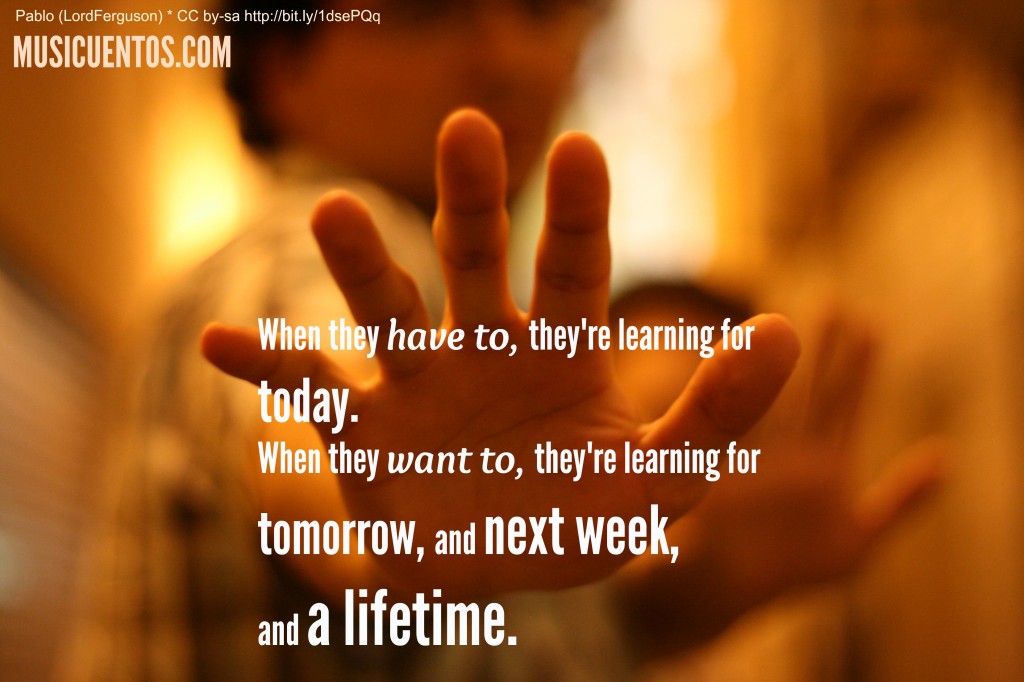In trying to tell a French teacher what I do the first day of school, I realized that my explanation of the first 12 days of Musicuentos Spanish 1 was, well, all in Spanish. So, here’s some English for you.
There are so many, so very many great language learning principles, right? So much second language acquisition research that shows students need
- time
- input they can understand
- opportunities to use meaningful language
- lots of time
- interaction involving negotiating meaning
- meaningful repetition
- more time
to be successful in acquiring a new language.
But oh, my teacher friend, if I could figure out the words to communicate how powerful it is to put in practice what is, to me, the most important thing every language teacher needs to realize:
It’s taken me a long time to come to the place where I’m willing to say that if we believe that motivation is a key factor -perhaps the key factor- in language learning success, our practice ought to reflect it – always. I’m still figuring out what that looks like. We can give the homework and give the assessments and put the grades in the gradebooks, we can put up fancy posters and duct tape and send home fancy infographic newsletters and syllabi, but if we haven’t accessed what students are motivated by – not how we can motivate them, but what factors within them motivate themselves – we’ll lose them as soon as the requirement is fulfilled, or there’s a schedule conflict, or they move to another city. And if native speakers can lose proficiency in the language they were born into, our best long-term-memory-building games and techniques aren’t going to stand against the test of years of ignoring the L2.
Okay, /soapbox. It’s me, and I always have to start with a bit of theory before I apply it. My application here is pretty simple: in the magic, difficult question of what motivates students, one answer that many teachers have found is that students are motivated to keep learning simply by a little success in the first place. I’m sure you’ve experienced it before; when you succeed at something, you want to keep doing it.
Students don’t come into your classroom expecting to succeed. If you’re going to speak to them in the target language, they expect to be lost. If you can communicate to them on the very first day that they can understand, it’s incredibly empowering. And it’s fun. You get to watch their eyes light up as they think
Wait a minute.
She’s speaking Spanish. (or French or whatever)
And I understand her.
And I’m answering her!
Whoa!
In my classroom, my policy is students get their syllabus and they know how to read and they can read on their own time (I refuse to publish grades until parents and students have signed and returned my syllabus). We can talk about procedures on the second day. The first day is all about fun, and it’s all about understanding.
So my suggestion is to spend the first day showing students that they will be able to understand you, and I start by explaining this:
Welcome to Spanish class.
It’s Spanish class, so I’m going to speak a whole lot of Spanish.
But whether you understand or not is primarily my responsibility. Your responsibilities are to 1) listen, 2) watch, and 3) tell me when you don’t understand. If you do that, and I’m doing my job, you’ll understand. I promise. Don’t believe me? Let’s try it.
And then I launch into a story. Your story will vary depending on your student level and demographic and so on, but basically, it’s just something to show them that because you’re willing to draw, gesture, act, sing, or whatever, it’s going to be fun, and they’re going to understand. Here’s my first-day story for Spanish 1 (100% in target language):
Let’s draw a boy (girl). [I draw a girl, students do as well.]
What’s the girl’s name? Jane? Emma? Angelina Jolie? (Girl in class)? No. What’s her name? [Students choose a name-María. Write ‘María’.]
Okay, her name is María. Hi María. Everybody say hi, María.
What color [emphasize] is her hair? Blue? Red? Brown? Black? [Point to colors or use color cards until students understand and choose a color – this is the pattern through the story. Point, students understand, draw.]
How does she feel? Is she happy? Is she sad? Is she angry? [Students choose, draw facial expression.]
What’s the girl like? Is she fat? Is she thin? [Choose, draw.]
What’s the girl wearing? A shirt? A dress? A tutu? What color?
I know, it’s not really a story, but you get the idea. We may get into what kind of hair she has (curly, straight), whether she has glasses, how old she is, where she’s from, and so on. I do this on day 1 with Spanish 1 and students understand the whole thing and answer all the questions and draw everything, because I’m coaching them through it. Do they acquire the ability to use this language? Of course not! But that wasn’t my point – my point was to empower them with the knowledge that they can comprehend in this class when it’s all in Spanish, and it will be fun. In this first class we might also playfully work on learning names (using “his name is…” etc.) and play a song that’s fun and targets some goal (such as Aserejé to simply show them that part of learning language is wrapping your mouth around the words, and to get them having fun using language) Later, the character they created becomes a character in the first stories (she makes friends with a Martian penguin and then disappears as the penguin and Garfield become our primary Spanish 1 characters).
How will you make the first day of school about helping students find that they will understand, they will have fun, and this motivates future learning?
For more ideas on comprehensible input on the first days of school, check out this great post by Cynthia Hitz and Martina Bex’s First Days tag.
5 Comments
Comments are closed.




Thanks for making a post about this, I really appreciate it!
Did I read right that you have students draw along with you?
And clearly, by my first comment, I meant “do you have students draw the same thing as you?” or do you let them “choose their own adventure?”
Yes – students’ required supplies were 1) a composition notebook and 2) colored pencils. The rule was, whatever I draw, you draw. Students knew it would come up in a “pop” quiz within a couple of days: “What is the girl’s name?” They were allowed to use anything they had received from me, notes included, so they knew they could get the questions right if they drew good “notes.” The quiz was about comprehension, not memory, so I wanted them to use the notes. HTH!
[…] think what Sara-Elizabeth posted about the first day story – letting kids see what they can understand on day one is SO CRUCIAL. I’m starting […]
[…] we’ll head into a second day story, and I’ll have students draw along with me. We’ll talk again about how we understood […]